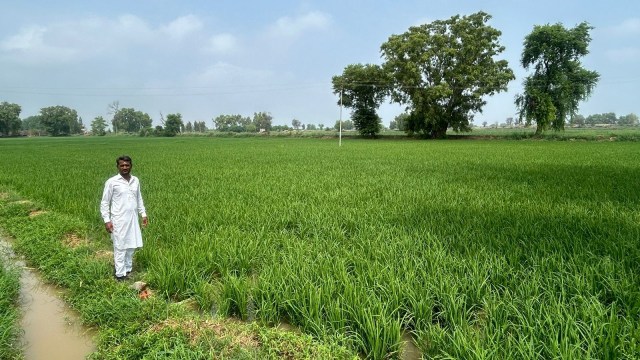Abohar, Punjab’s mini California, ‘ditches’ kinnow orchards, takes up paddy after grim harvest
According to sources in the Agriculture Department, over 1,000 acres of kinnow orchards in Fazilka district have made way for paddy cultivation this year
 Killianwali village of Abohar is having paddy fields this time
Killianwali village of Abohar is having paddy fields this time
Often referred to as Punjab’s mini California, Abohar in the Fazilka district is famous for its kinnow orchards. Dependent on canal water owing to the high saline content in groundwater, the farmers in this area banked on kinnow orchards due to their ability to survive with less water compared to other water-guzzling crops. Cotton, too, was preferred due to the same reason.
However, this season, a change has been observed in the kinnow belt of Punjab, with farmers sowing paddy, primarily basmati varieties, after uprooting their orchards.
Mandeep Singh, a former sarpanch of Giddranwali village in Abohar, said, “I uprooted my 22-year-old kinnow orchard after trees completely stopped bearing fruits. The canal water often gets contaminated by toxic water from Ludhiana’s Buddha Dariya”.
“Moreover, water shortage is also there. When everyone in Punjab is growing paddy and earning good money, we thought we should also do it. I have replaced my kinnow orchard spread over eight acres with paddy saplings. I have sown PR 131 and Basmati 1718 varieties,” he added.
Another local farmer, Gursewak Singh said, “I have replaced cotton with paddy, but in my village, several farmers have started cultivating paddy in their kinnow orchards.”
“In fact, those who can bore a tubewell and the groundwater is comparatively less saline, are switching to paddy. I, too, have grown paddy but only on two acres in place of kinnow,” said Darshan Singh Giddranwali, a farmer in Giddranwali village.
Asked about the new trend, Abohar MLA Sandeep Jakhar, who has some farmland in Maujgarh village, said, “Owing to phytophthora infestans, kinnow plants had stopped bearing fruits. Hence, this time, I have tried cultivating paddy by uprooting kinnow orchards on a five-acre area.”
“What should a farmer do when you are left with no choices? Many other farmers are also doing it on a small scale to survive. Those whose quality of groundwater is a tad better, are mixing it with canal water to irrigate paddy. Something is better than nothing. We are also trying our hands at guava, malta, and carrots by replacing cotton,” Jakhar added.
Contradictory figures
Abohar and Balluana areas of the Fazilka district have around 35,000 hectares under kinnow. The Horticulture Department said new kinnow orchards were planted on 850 acres of land, while around 70 acres of kinnow orchards had come under the National Highways Authority of India’s Bharatmala project in 2023-24. Hence, horticulture authorities maintained that the shift to paddy is in less than 100 acres.
When contacted, Shailendar Kaur, Director, Horticulture Department, said the shift towards paddy is not much. “It is less than 5 per cent of the total area under kinnow cultivation. However, new orchards have also come up. Most of the farmers who have tried paddy this time are the ones whose orchards are more than 25 years old. In the last two years, kinnow glut also crashed the prices of the fruit as well,” Kaur said.
However, farmers said that the area under paddy in Abohar and Balluana was much larger. “Officials of the agriculture and horticulture departments should visit a few villages to find the exact area under paddy cultivation,” said Gursewak Singh.
Sources in the Agriculture Department seemed to contradict the claim of the Horticulture Department. They said more than 1,000 acres of kinnow orchards have made way for paddy cultivation this year. Until Friday, the total area under paddy cultivation in the Fazilka district was 1 lakh hectares, the same as last year, but it is expected to increase as final reports are yet to be compiled.
In Fazilka, only 50,341 hectares were under cotton cultivation this year compared to 92,000 hectares last year. Sources said a few cotton farmers switched to paddy following pink bollworm and white fly attacks on crops.
More subsidy
Meanwhile, Shailendar Kaur said the soil conservation department gives an 80 per cent subsidy on the installation of a drip irrigation network in the new orchards. “The horticulture department will give an extra Rs 10,000 per acre to the farmers for using drip irrigation methods. I am sure farmers will get attracted to this,” she added.
Notably, women farmers and those from the Scheduled Caste communities get a 90 per cent subsidy on the installation of drip irrigation networks in their fields.












